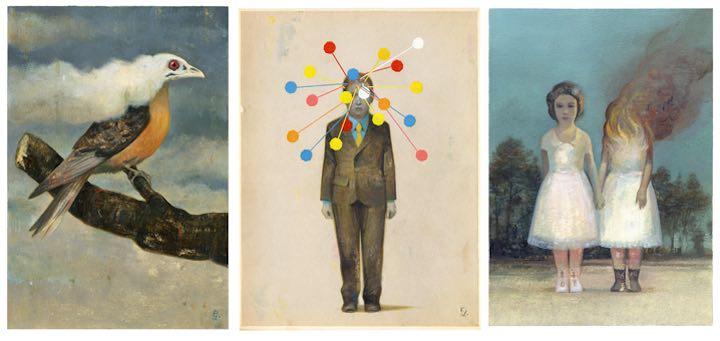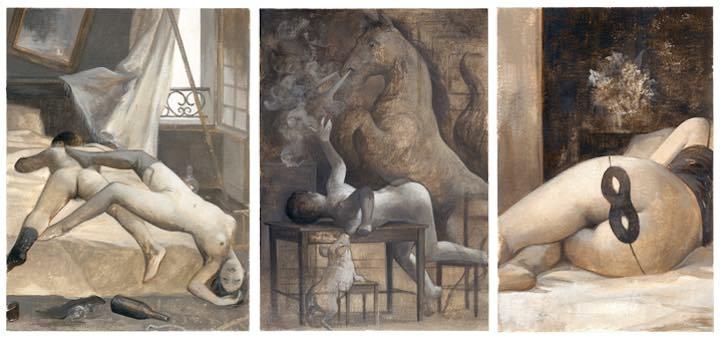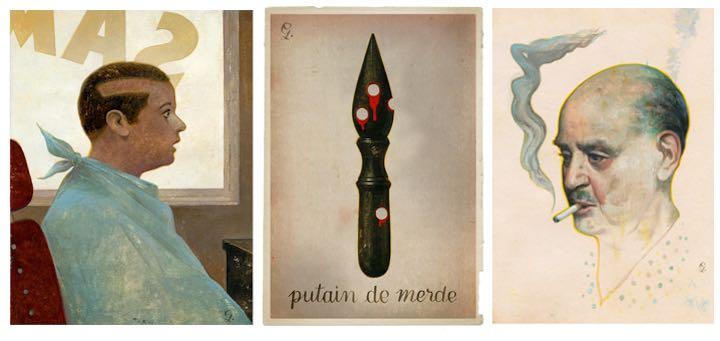The Q&A: Gerard Dubois
Q: Originally from Paris, what are some of your favorite things about living and working in Montreal?
A: It is a great crossover between European and North American cultures, which is exactly what I needed. A few degrees warmer, I would have said a perfect place!
Q: Do you keep a sketchbook? What is the balance between the art you create on paper versus in the computer?
A: I keep two separate sketchbooks in my studio: one in which I do my sketches for jobs, although I draw more and more on computer; a second one for whatever I have in mind, but personal; and finally a third one, pretty small, to bring with me to draw ideas when I’m outside of the studio.
I would say the balance is getting close to 50/50. Since Photoshop work is newer to me, I enjoy it maybe a bit more; it’s like a new toy.

Left to right: Saving our birds, The New-York Times; Alzheimer’s, Stanford Medicine; Image from Révélations photographiques, illustrated book.
Q: What do you like best about your workspace?
A: It’s a nice extension from the house, with seven windows on three walls. But mostly it is pretty private, so I can play music as loud as I want all day without getting on anybody’s nerves. I like to be by myself when I’m working.
Q: Do you think it needs improvement, if so, what would you change?
Q: It's a structure from the 50’s without foundations, and with all the old windows it becomes a freezer in winter, a furnace in summertime.
Q: What is the most important item in your studio?
A: Obviously my computer, more than my painting set, which is probably depressing; almost everything I do during a workday has to go through it: drawing, scanning, reading, playing music, connecting with people, etc.
 Left to right: Images from Les aventures illustrées de Minette Accentievitch.
Left to right: Images from Les aventures illustrées de Minette Accentievitch.
Q: What was the strangest or most unusual assignment you’ve taken? What did you learn from the experience?
A: I would probably say doing 40 illustrations for a highly erotic book. The title was "Les aventures illustrées de Minette Accentievitch.” It was unusual in the sense that on paper, it was the kind of project that didn’t have a single chance in a million to happen.
It started as a small black-and-white project, to be printed on cheap paper, and ended up as a 173-page book, printed four colors (5 on the cover), selected for AIGA 50 Books/50 Covers (2010), with exhibitions in Paris and Montreal, reviews even in papers like Le Monde, TV, radio, etc.
Working with my long-time friend and tremendous art director, Louis Gagnon, of Paprika, with a fantastic text from a Serbian poet, a great publisher, Brigitte Bouchard, a good friend too, a subject I have to admit I like very much, carte blanche on all images—dreaming is still possible.
Q: What was your favorite book as a child?
A: I don’t remember growing with a “favorite book.” I was not reading that many comics either, besides the Belgian classics, but the first graphic book I loved, as a child, was a facsimile of the first Tarzan, by Burne Hogarth. But if I had to pick one children’s book it would definitely be Struwwelpeter by Heinrich Hoffman.
 Left to right: Ten Lessons Learned from Others’ Mistakes, Plansponsor; Hommage to Charlie
Hebdo, L’Obs Magazine; Portrait of Albert Cohen; client: Odéon Theatre.
Left to right: Ten Lessons Learned from Others’ Mistakes, Plansponsor; Hommage to Charlie
Hebdo, L’Obs Magazine; Portrait of Albert Cohen; client: Odéon Theatre.
Q: If you had to choose one medium to work in for an entire year, eliminating all others, what medium would you choose?
A: Probably black ink. Could be a Bic, a fountain pen, whatever, but with black ink. It is the medium I have always worked with for as long as I can remember. I’ve never liked pencils, I almost never draw with them.
Q: What are some of your favorite places/books/blogs/websites for inspiration?
A: I buy a fair number of art books, illustrated books, children books, but favorite, I can’t say. I guess I need all of them when I need to be inspired. I also need a lot of music, old, new, all genres, all day, to be inspired or in a mood to work. I do not have a routine, but among the regular blogs and websites I follow are Plus ou moins 30 (about illustrators from the 30’s); L’amour qui bouquine (an online bookstore of beautiful vintage limited edition erotic books); and Lunettes rouges (a blog on art and exhibition reviews).
Q: What was the painting or book or film that most affected your approach to art? [the Thunderbolt]
A: There are a few I can think of, like a small Juan Gris monograph I got as a gift when I was 12 and knew nothing about art, or an old collection of books with black and white reproductions tipped in, like Maillol, Poussin.
But if I only have one choice, for everything it gave me, I would say Les enfants by Balthus. It is difficult to explain why I was struck by it many years ago. It is a pretty classical image with nothing apparently special about it. But the colors, the theme, the light, textures, even the furniture. It was like when someone says exactly the words you were about to say, except you are mute. I think it helped me to see more clearly what I wanted to express with my work.
Q: If you could be anywhere but where you are now, where would that be?
A: Somewhere warmer for sure. Probably Barcelona. For my wife, because loves this city for its beauty and food; for my eldest son so he could go to the Camp-nou and see his favorite football team; and for my youngest, because it’s the second heaven (after California) for skaters.
 Left to right: Death of a Salesman,
Entertainment Weekly; Nothingness, Nautilus.
Left to right: Death of a Salesman,
Entertainment Weekly; Nothingness, Nautilus.
Q: Where do you teach—and what do you like best about teaching?
A: I teach at the University of Québec in Montréal (UQAM). It is such a pleasure to meet so many talented young people, to exchange ideas and see them becoming accomplished artists over the years. It makes me happy just to see their skills and creativity blooming.
Q: Where did your idea for your book, Un verger dans le ventre (an orchard in the belly) originate? What was the most difficult part about getting from idea to finished art?
A: Un verger dans le ventre, came as a breath of fresh air. The text wasn’t mine, but it had the kind of fantastic little twist I like. The editor, Nadine Robert, trusted me when I explained that I wanted to do it with a technic different than my painting style. It was a stressful process because I had never really worked this way before, but in the most positive way. I’ve enjoyed all the long hours finishing every little detail, working on a special layout, and typography for the cover. I wasn’t even sure I would succeed but I had to go for it.
Q: What advice would you give a young artist about applying to an art school or college?
Above all, I would say: don’t forget to have fun. You make art because you love it, because you love to draw. So enjoy it as much as you can.
Q: What would be your last supper?
A: In case I do not have my teeth anymore, I’d say a steak tartare, a nice Roquefort (Edel Rodriguez’s favorite) and some bottles of good wine and scotch.
Gérard-DuBois
Born in France in 1968.
Studied graphic design in Paris.
Graduated after five
years in 1989, then crossed the Atlantic to live in Montréal, Canada, to work as an illustrator.
Since then, his work has appeared in major North American publications, among
them The New York Times, The Wall Street Journal, Time magazine, GQ, Rolling Stone, The New-Yorker, The Washington Post, Le Monde, XXI, The Guardian, Playboy, Newsweek, Entertainment Weekly,
Harper’s, The Atlantic, among others.
His work has been profiled by Print Magazine , Communication Arts, Grafika and l’Actualité.
His illustrations
have been awarded in major contests, including American Illustration, for the past 15 years. and have received four Gold Medal from the Society of Illustrators in New York. His original art has been
exhibited in Chicago, Los Angeles, New York, Paris, Montreal, Toronto.
His paintings are now in many private collections from Rolling Stone magazine to Stephen King, Guillermo Del
Toro.


